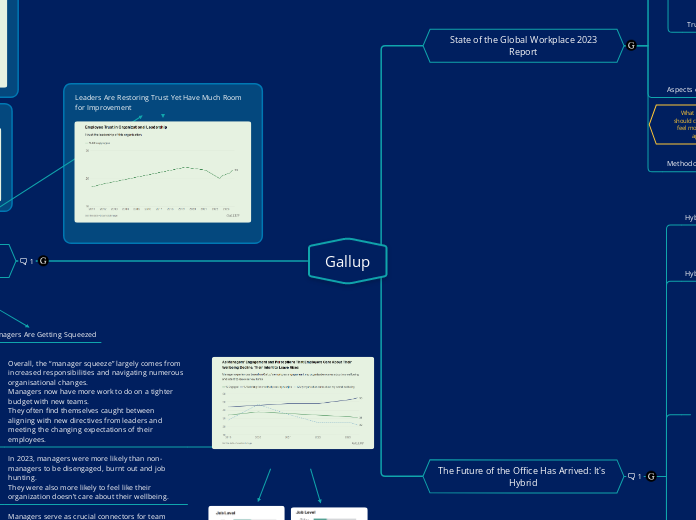Gallup
In 2022, employee engagement and job opportunities surged globally, coming back in line with pre-pandemic historical trends on economic development and growth. [...] At the same time, global worker stress remained at a historic high
Engagement ≠ happiness!
True engagement means your people...
...are psychologically present to do their work
...understand what to do
...have what they need
...have a supportive manager and a supportive team
...know why their work matters
Aspects of work to change
Methodology
The total number of global employed respondents included in the full trend of data (2009 through 2022) is 2,208,292; for the 2022 data, the total is 122,416
Data obtained from April 2022 to March 2023 (reported as part of 2022 data)
Engagement
Hybrid is here to stay
Hybrid policies
Hybrid Benefits
Better work-life balance,
More efficient use of time
Less burnout at work
More autonomy
Larger talent pool
Significantly higher employee engagement*
Lower turnover intentions*
Increased productivity*
Best Practices for Hybrid Workplaces
Create a “workplace value proposition.”
Empower the team
Retool performance management
Train managers and their teams
Beware of the real estate bust
Organization changes made in 2023
51% cited the restructuring of teams
42% reported budget cuts
64% said employees were given additional job responsibilities
Global Worker Stress Remains at a Record High
Engagement Is Slowly Recovering, With Some Areas for Improvement
Leaders Are Restoring Trust Yet Have Much Room for Improvement
Managers Are Getting Squeezed
Overall, the “manager squeeze” largely comes from increased responsibilities and navigating numerous organisational changes.
Managers now have more work to do on a tighter budget with new teams.
They often find themselves caught between aligning with new directives from leaders and meeting the changing expectations of their employees.
In 2023, managers were more likely than non-managers to be disengaged, burnt out and job hunting.
They were also more likely to feel like their organization doesn’t care about their wellbeing.
Managers serve as crucial connectors for team collaboration and effectiveness
Managers account for 70% of the variance in employee engagement.
Organizations Need a Long-Term Hybrid Work Strategy
Low Engagement costs the global economy $8.8 trillion. That’s 9% of global GDP
*when compared to remote-capable
employees working on-site
Engagement
*published research on this topic is sparse and shows mixed results
31% of leaders and managers and 52% of hybrid workers "feel" hybrid work increases productivity
Early studies warn that fully remote work could moderately decrease efficiency in certain jobs
Hybrid work has tended to yield small to moderate improvements in efficiency.
Engagement
Stress
Anger
Europe
The balancing act:
Organization-wide mandates often backfire and disengage employees
Failing to ensure hybrid schedules are well-coordinated erode teamwork and culture
Europe
Hybrid workers are most engaged when their team works together to determine their hybrid schedules.
The least common approach only 12% uses a collaborative decision-making process.
Engagement
Stress
More engaged employees
are less stressed
Stress level also depends
on work arrangement
